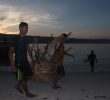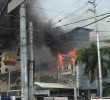II. A NEW MILITARY STRUCTURE?
On 23 January 2007, Wiwin Kalahe, one of the most wanted men in Poso, turned himself in to the police. Suspected of involvement in a string of JI murders in the area, he turned out to have a wealth of information about JI safehouses in Java, because he had stayed in several after fleeing Poso temporarily in July 2004 following the killing of an Indonesian soldier�s wife. After his surrender in January, police took him back to Java and asked him to point out these locations. They were put under surveillance, and the waiting paid off.
On 20 March 2007 police followed two men on a motorcycle, Agus Suryanto, 39, and Sarwo Edi Nugroho, 40, from Agus�s house in Muntilan, Central Java to a small store in Sleman, Yogyakarta where three others were waiting: Akhyas alias Sutarjo, Sikas and Amir Ahmadi. The two groups were each carrying a box, and as they exchanged them, the police moved in. Agus was shot and killed as he tried to flee; Sarwo Edi was wounded. The box they were carrying turned out to contain two M-16 rifles, a revolver, a pistol and about 100 rounds of ammunition. The other three men were arrested, and in their interrogation, police learned that Akhyas had stored explosives at Sikas�s house in Sukoharjo, Solo.
The next day, Sikas led police to a cache that included over 2,000 bullets, twenty kilograms of TNT and close to 700 of potassium chlorate, 200 detonators, a few guns and sixteen small pipe bombs. He told police he had been storing the material on the instructions of Abu Dujana, one of Indonesia�s most wanted men, who is frequently � and erroneously � reported to be the current amir (leader) of JI. Two days later, police arrested Saiful Anam alias Mujadid alias Brekele, 26, in Temanggung, Central Java. Another of Poso�s most wanted men, he is suspected of being a perpetrator of the May 2005 bombing in Tentena market that killed 22 people. Almost simultaneously, police in Surabaya arrested Maulana Yusuf Wibisono alias Holis or Cholis, and five days later, Achmad Syahrul Uman alias Doni alias Khoirul. It later transpired that Akhyas in Sukoharjo had supplied explosives to Maulana in Surabaya, who in turn got them to Poso.
All the men were said to be part of a new JI military structure, depicted in a hand-drawn diagram that police released to the media in mid-April. It had a qoid sariyah (sariyah leader) on top, with four units called ishoba under him. According to the arrested men, Abu Dujana was the qoid, and the ishoba were based in Solo, Jakarta, Semarang and Surabaya. The latter two were headed respectively by two of those arrested, Sarwo Edi and Maulana. The detainees named the ishoba heads for Jakarta (Dani) and Solo (Gulam alias Tanmin), but both remain at large.
The significance of the diagram is not clear, particularly because the structure covers only Java, and the term used is sariyah. According to Indonesian police, this concept of the sariyah was first discussed in August-September 2006 and then announced by Abu Dujana to a JI meeting in Sukoharjo, Solo in December as a reality. However, elsewhere the term has been used to mean a sub-section of a larger military organisation. In JI�s 1996 organisational guidelines (PUPJI), it denoted a level beneath the wakalah, thus covering something less than a province, or in military terms, a unit below a battalion. In his 2005 testimony, Bali II plotter Subur Sugiarto said that JI�s structure had changed the previous year, and sariyah had become equivalent to a kabupaten (district) � thus even smaller than envisaged in PUPJI.
Around the same time, in 2004, a document � Serial Jihad IV � began circulating among those close to Noordin Mohammed Top. Apparently translated from the Arabic, it is a manual for urban guerrilla warfare with specific guidelines for setting up a �super-secret�, small urban hit squad. The basic unit is a thoifah consisting of a leader and his deputy, who oversee the necessary planning and training; a data collection unit of not more than four people with good communication and computer skills to gather basic intelligence and survey possible targets, including photographs; a logistics unit to purchase, rent or otherwise acquire the necessary equipment and facilities, prepare documents, and acquire bombs, poison or other weapons of choice; and finally the executors. Such a thoifah, the document suggests, is a combat cell (fi�ah muqotilah). Four of these make a kirdas, and four kirdas make a sariyah, which operates in a territory that covers about 50 sq. km.
Outside Indonesia, the Arabic plural of sariyah (saraya) is used by some jihadist groups. Meaning brigades or platoons, it appears in the name of the military wing of Islamic Jihad in Palestine, saraya al-quds (the al-Quds brigades). It is also used by a number of Iraqi jihadist groups which in 2006 reputedly joined the Mujahidin Shura Council established by al-Qaeda in Iraq, such as saraya ansar al-taweed (the tawhid partisans brigades). Again, the usage suggests that a single sariyah is unlikely to represent a full military organisation.
Terrorism









